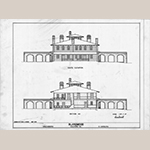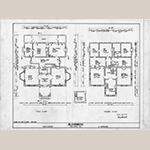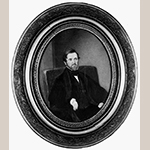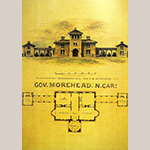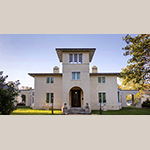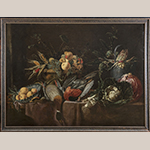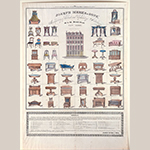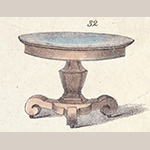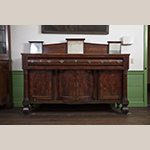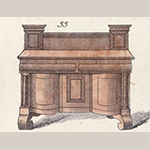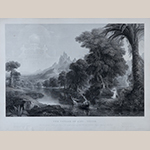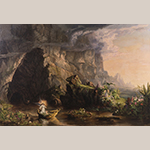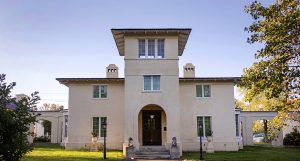
In 1844, as Governor John Motley Morehead launched an expansion of Blandwood, his Greensboro, North Carolina residence, he embraced emerging national trends in architectural design and the arts, and, at the same time, adhered to regional tastes. Morehead hired the noted architect Alexander Jackson Davis of New York City to undertake the project, and over the next few years they discussed the furnishings and interior details as well as the building of Blandwood. Their conversations reveal the nuanced taste of a forward-thinking statesman and the broad tastemaker role of a prominent architect.
Ultimately, Blandwood reflects Morehead’s respect for North Carolina’s political climate, agrarian setting, and industrial future as well as Davis’s vision for a harmonious blend of architecture, landscape, and furnishings. This antebellum mansion, as a result, not only documents a significant statesman/architect partnership but also embodies tensions apparent in nineteenth century material culture.
— ♦♦◊♦♦ —
As a young Greensboro attorney with a wife and children, in 1827 John Motley Morehead (1796–1866) (Figure 1) purchased a two-story Federal-style farmhouse. Named Blandwood for its original owner and builder Charles Bland (d.1841), the house had been constructed at the end of the eighteenth century in Guilford County, years before the city of Greensboro was founded in 1808 (Figure 2).[1] Morehead purchased the house and surrounding thirty-two-acre property from Henry Humphreys (1787–1840), who was married to former widow Letitia Harper Lindsay (1785–1835), mother of Morehead’s wife Ann Eliza Lindsay (1804–1868).[2] Humphreys was a successful North Carolina industrialist and had in the 1820s updated Bland’s original farmhouse, which is still visible on the back, or south, side of the mansion (Figure 3 and 4).[3]
Seventeen years after buying Blandwood, in 1844, Morehead was serving his second term as North Carolina’s governor. With Ann Eliza he had a large family soon to include eight children. He was ready to transform Blandwood into a refined dwelling, an environment appropriate for the Morehead clan and for a man of political prominence with significant social standing.
When Alexander Jackson Davis (1803–1892) (Figure 5) met with Morehead on 3 February 1844 in Greensboro, North Carolina and examined the grounds at Blandwood, the two men launched a long, enduring friendship.[4] Both men were visionary figures. Active on the national political scene, Morehead later became known as the “father of modern North Carolina,” a progressive leader who advanced public schools and roads, and achieved a railroad for the state, enabling its transformation from a rural to an industrial economy.[5]
Davis was nationally famous by 1844. He met Morehead through University of North Carolina President and former North Carolina Governor David L. Swain (1801–1868), who had invited Davis to expand the Chapel Hill college campus. In addition to government and academic buildings, Davis designed many romantic country houses for which he became noted.[6] In Greensboro, Davis examined the governor’s grounds, designed an expansion, charged his client $100, and created a residence that today represents the country’s oldest extant Tuscan villa, a model that shaped American homes for decades.[7]
Davis came to Morehead with stellar references. It was North Carolina native and New York businessman turned art patron Robert Donaldson Jr. (1800–1872) who had first recommended Davis to Governor Swain. Donaldson and Morehead had been university classmates. In these men Davis found a progressive spirit, and it is not surprising his design for Blandwood was similarly advanced.[8] It was trusting of Morehead to accept, without question, Davis’s novel Tuscan villa plan for his Federal farmhouse in rural Guilford County.
A creative Classicist working in several stylistic modes, Davis bypassed the conventional Greek Revival “temple” model for Blandwood.[9] In the process, he devised a new residential formula, the Italian Tuscan villa, a form that seemed especially suitable for his elite North Carolina client and compatible with a restrained Classicism. Davis’s colleague and friend, A. J. Downing (1815–1852), a landscape designer and tastemaker who popularized Davis’s ideas, identified the country villa as the “most refined home of America—the home of its most leisurely and educated class of citizens.”[10]
Davis kept Blandwood’s original dwelling and added to it a monumental north-facing façade. That façade featured plain stucco surfaces, arched openings, bold wings, flanking arcades, dependencies, and a signature three-story central prospect tower (Figures 6 and 7). The first level of the addition included a portico leading to an entrance hall in turn opening on either side onto grand twin parlors. The parlors terminate in dramatic window bays with floor-to-ceiling windows. The second floor added living space, including a sitting room and several bedrooms. A third level in the central tower contained multiple windows and more interior space.
From its windows, Davis filled Blandwood with light and views of the exterior, thereby paying homage to Morehead’s surrounding landscape populated by bushes, flowers, and abundant trees. It was a unified design for the governor and his visitors to enjoy from within and from without.[11] The integration of dwelling and landscape—central to Downing and Davis’s Picturesque philosophy and current nineteenth century thinking—was such a defining feature of their composition that Downing immediately published Davis’s drawing of Blandwood in the second edition (1844) of his book, A Treatise on the Theory of Landscape Gardening (Figure 8).[12]
The harmony that these tastemakers professed encompassed Blandwood’s interior as well. At a time when architects rarely considered interiors, Davis was devoted to the full picture. As early as 1827, he exhorted: “Leave the [educated architect] unshackled in his design. Throw on him the responsibility of taste.”[13] Davis viewed himself as an “architectural composer,” as he stated on his business card (Figure 9), overseeing the entire work, and his newspaper ads promoted services in architecture, landscape, and furniture.[14]
Downing articulated the idea of intelligent unity. He wrote in Architecture of Country Houses: “When a villa is designed by an architect, he generally superintends and directs the finishing of the interior… .” Later in the book he defines this drive: “The province of the architect does not cease with designing the general plan and exterior of any building, but that he should carry out the same spirit or style in all parts of the edifice…an intelligent unity reigning over the whole.”[15] Donaldson had even commented on Davis’s unifying powers. He wrote, “Davis is perfectly equipped to furnish besides architectural design to arrange…in the best manner…globes, maps, prints–paintings and whatever may be there now or added thereafter.”[16]
That Davis succeeded in creating an impressive, coherent dwelling mirroring his client’s refinement is borne out by the praise contemporaries gave Blandwood. Within just a few years of the mansion’s completion, the Raleigh Register observed that Morehead had “the most elegant residence of any private gentleman in the State, in which he dispenses with open heart, liberal hand, and true North Carolina courtesy, the old-fashioned hospitality of his fathers.”[17]
— ♦♦◊♦♦ —
Blandwood was restored in 1976 (Figure 10) and sits on the National Register of Historic Places. Operating as a house museum today, the mansion showcases original furnishings donated by Morehead descendants. These items date mostly from the antebellum decades of the 1840s through the early 1860s.
Armed with voluminous Davis archives, scholars have amply documented his architectural legacy, including his larger residential commissions that often involved furniture designs.[18] While scholars have not examined in detail the antebellum artifacts and interior architecture of Blandwood, Davis’s role in shaping that interior is significant in terms of the architect’s own oeuvre and of antebellum material culture. The mid-1840s exchanges between Davis and Governor Morehead regarding Blandwood’s art, interior details, and furniture reveal Davis creating a genteel stage for his client and performing the unifying tastemaker role described by Downing.
Their conversation also delineates the tensions a southern gentleman client faced as he balanced tastes both elite and popular, urban and rural, northern and southern, romantic and industrial.[19] Compromises were necessary even though Davis and Morehead clearly respected one another. Davis boasted about his princely North Carolina client, and he knew Morehead and his large family inhabited the refined sphere the architect sought to promote.[20] But taste proved no simple matter.
On 29 February 1844, just weeks after designing Morehead’s villa, Davis attended a painting sale (a routine event for him) and bought seven works of art and earmarked three for Morehead (Figure 11).[21] Knowing only their titles and prices, Morehead agreed to Davis’s proposal and purchased the three paintings. The shipping logistics were complex: the art had to be sent from New York to Petersburg, Virginia, a regional transportation hub, then transported to Raleigh where Morehead lived while serving as governor.[22] A year later the paintings would have to be shipped to Blandwood once the governor completed his second term and the expansion of Blandwood was closer to completion. Anticipating such complications, Morehead chose to wait before buying more art from Davis. His enthusiasm was apparent, though, and he was clearly committed to the idea of buying more art from his architect.[23]
The paintings Morehead purchased from Davis were a still life and two landscapes, as well as two additional frames. The still life, Large Fruit Piece, hangs today at Blandwood (Figure 12). It descended through the family of the governor’s youngest child, Eugene Morehead (1845–1889), who inherited Blandwood and many of its furnishings upon his mother’s death in 1868.[24] The still life oil painting measured four feet by five feet. Davis called it a De Heem, referring to Jan Davidsz de Heem (1606–1684), a major Dutch painter of the seventeenth century. However, the painting is actually an eighteenth-century copy in the manner of this Dutch master.[25] Davis himself collected and sold many highly desirable copies that, like Large Fruit Piece, would have been at that time considered the work of an Old Master.
The two landscapes Morehead bought from Davis were Winter Scene by the Frenchman Louis-Claude Mallebranche (1790–1838) and Sunset on Water, by an unknown artist. Populated by small figures in a wintry setting, the scene in the Mallebranche painting is near Montreuil, France, or suburban Paris. Mallebranche was known for his European landscapes and winter scenes.[26]
Large Fruit Piece cost Davis $8.00; he sold it to Morehead for $10. Winter Scene cost Davis $25.25; he sold it to Morehead for $26. Sunset on Water cost Davis $29; he sold it to Morehead for $30. Morehead also paid to have the two landscapes framed; Large Fruit Piece apparently came with its own frame.[27]
Davis’s proposal and Morehead’s enthusiastic response underscore how much both men valued art. Acquiring art and books about art was a passion for the erudite Davis, who believed paintings along with sculpture were the handmaidens of architecture, the “queen of all arts.”[28] He carefully recorded each acquisition by source, genre, and client. Morehead’s own interest in the arts proved a subtext for his relationship with the like-minded Davis. While known as “ “lawyer, statesman, financier and railroad prince,” Morehead was also remembered as a “young man [who] played well on the flute, had a great love of beauty, was very fond of pictures and architecture.”[29]
Gentlemen like Morehead in the 1840s regularly placed art, primarily portraits, on the walls of their homes; however, among the elite, a new trend emerged for landscapes and copies of Old Masters. Displaying art generally conveyed one’s sense of refinement and self-improvement, and landscapes in particular became status symbols.[30] In buying a still life and landscapes from Davis, Morehead reached beyond the traditional portraiture genre to embrace new artistic forms, and he let the architect’s choices fashion a refined tone for Blandwood’s grand spaces.
The visual harmony of Blandwood’s interior as well as its layout of art were undoubtedly meaningful to Davis. Designed to accommodate the frequent entertaining for which the Moreheads were known, the two large parlors (twenty-one feet by nineteen feet) were likely the spaces Davis envisioned for the art he sold Morehead. While the space above the fireplaces in the two parlors would have been reserved for gilt-framed looking glasses, plenty of wall space remained for the large still life painting and the two landscapes—especially since Davis favored stacking the art on walls.[31]
At the same time Davis recommended the three paintings to Morehead, he also offered “plaster and alabaster ornaments,” most likely Classically styled busts and urns or vases to be placed on pedestals or the two mantels in the new parlors.[32] For practical reasons Morehead postponed but did not reject purchasing these items. He admitted to Davis they were “rare and choice” items offered at a good price, but Morehead again wished to avoid complicated shipping logistics until he returned home to Blandwood.[33]
The ornaments Davis offered were meant to convey the interior’s prevailing Classical theme—speaking to Davis’s and Morehead’s shared erudition and taste. Besides harmonizing Blandwood’s visual statement, Davis early on insisted the house have the requirements of refined spaces: “places dedicated to leisure and to higher pleasures of the mind.”[34] Davis’s direction recalled Downing’s instruction to enrich villas “amid the serenity of sylvan scenes… [with] objects of universal beauty.”[35]
— ♦♦◊♦♦ —
As the local contractors William Conrad (1817–1850) and his father Joseph Conrad (1791–1873) of Davidson County began executing Davis’s plans for Blandwood, the statesman and the architect corresponded about basic construction points: materials, suppliers, dimensions, hinges, bolts, locks, doorknobs, and glass.[36] Morehead’s attention to these details is startling given his preoccupation at that time with national politics, the state’s governance, and Edgeworth Female Seminary, the Greensboro school he founded in 1840. He concluded more than once that while he did care about quality, final decisions for Blandwood should rest with Davis. Morehead expressed his confidence in his architect’s ability to achieve the desired overall harmony. He wrote Davis: “I trouble you to locate the articles… of such quality as your taste shall seem suitable to the House.”[37]
In the spring of 1844 Davis proposed installing small paintings in the panels of the parlor doors. Davis may have intended that his friend and colleague Thomas Cole (1801–1848), the famous landscape artist, complete these paintings. The idea of creating an art gallery within Blandwood’s parlors highlights Davis’s goal of fashioning a refined environment for his respected southern client. Davis had previously used the same technique in a commission for wealthy art collector Luman Reed (1787–1836) in New York City. Davis designed a space in Reed’s house where Cole, among other painters, was asked to create scenes for door panels.[38]
Morehead was most likely aware of Thomas Cole but not his contributions to Luman Reed’s galleries. Morehead found the concept of placing art in the parlor door panels radical. He wrote to Davis that the idea, in effect, might play well in New York City but not in Greensboro. Admonishing his architect (Figure 13), he responded: “I think we shall be refining rather too much for the state of our tastes + our friends here.”[39]
The give and take over the parlor doors demonstrated that Morehead trusted Davis’s taste, to a point. The governor understood that there were limits to what his North Carolina peers would accept. Morehead relied on Davis’s talent unifying Blandwood’s interior design and coordinating decorative objects–skills for which architects were not always known; however, he was aware of the tempering part he had to play. As their mutual friend Robert Donaldson once commented, “When [Davis] mounts the Pegasus of design, he may require the restraining taste of another.”[40]
Morehead had reasons to tread modestly in furnishing Blandwood, a home that national and local leaders visited often. The governor may have been erudite, but he was also praised as someone who could “walk with kings” while not losing the “common touch.”[41] During the early 1840s, when Morehead was governor-elect and later governor, controversy erupted in Raleigh challenging his party’s integrity and testing his own sensitivities to popular taste. The highly publicized “French Bedstead Scandal” charged Morehead and his political colleagues with hypocritically filling the governor’s Executive Mansion in Raleigh with “indulgent furnishings” and “detestable extravagance” when, in fact, his party had professed to espouse simple virtues and “log cabin” living.[42]
The satiric comments in local newspapers cited precisely the same elegant furnishings (French bedsteads, Grecian sofas, mahogany chairs, etc.) that Davis and Morehead later considered for Blandwood. The scrutiny of North Carolinians was most certainly still on Morehead’s mind when he wrote to Davis in May 1844 about the proposed art on the parlor door panels. The politician was mindful that such over-the-top refinement, or “frippery and finery” and “regal splendor,” as the pundits charged, would not be well received in the Old North State.
As an alternative to paintings for the parlor doors, Davis proposed looking glasses instead. At first Morehead objected to Davis’s compromise, but later he came around to the idea.[43] The mirrored panels (Figure 14) Davis installed on the parlor and bay doors were, in fact, significant because they not only added more light to the interior but also enhanced views of the exterior from within.
A central Davis concept for Blandwood was viewing the surrounding landscape from the interior. When the doors of the vestibule, parlors, and window bays were all open, his long vista from bay to bay created a dramatic space. (Figure 15). His signature window bays—each ten-feet tall, ten-feet wide, and five-feet deep—also offered places from which to contemplate the grounds’ scenery. The villa’s noteworthy central tower and its fenestration provided still more views of the surrounding landscape. This blending of architecture with the natural world was a unifying theme for Blandwood. It was also consistent with the Picturesque philosophy Davis and his New York intellectual coterie, including Thomas Cole, espoused in their efforts to venerate America’s natural landscape.
— ♦♦◊♦♦ —
Like the paintings, ornaments, and interior details Davis specified for Blandwood, the parlor seating furniture speaks to the refined spirit and unified, particularly Classical, themes Davis created for his client. Although Davis did not design this furniture, his imprint is evident. Parlors epitomized a dwelling’s gentility, and the furniture selected for those rooms assumed heightened status, representing a “generous zone of repose and refinement.”[44] The seating suite in Blandwood’s more formal west parlor descended through Eugene Morehead’s family.[45] The surviving mahogany suite consists of one large sofa (Figure 16), two small armless sofas (Figure 17), and three matching side chairs (Figure 18) that were originally part of a set probably numbering at least a dozen.[46]
The Classical style of the parlor suite mirrors Blandwood’s architecture. Noteworthy are the ceiling plasterwork with anthemion medallions (Figure 19) and friezes as well as the restrained Greek Revival fireplace surrounds. The Classical language of these details blends with the Tuscan villa’s spartan exterior.
Highly educated and trained in the classics, Morehead and his social peers as well as Davis, revered furnishings echoing a Greco-Roman civilization that American government and society hailed as their model. The silhouettes of the suite’s sofas and chairs derive from Classical forms—the Roman lectus or daybed for the sofas and the Greek klismos for the side chairs. Rosette, anthemion, tight scroll, and volute embellishments give further expression to the ancient antecedents. The sofas’ streamlined silhouettes along with mahogany veneered rails, tamed outward swept arms, molded strapwork, neatly placed ornament, and bracket feet all keynote the particular phase of Late Empire Classicism known as French Restauration.[47]
Notable scholars have claimed that Davis referred generally to purchasing furniture for Morehead.[48] Yet, no surviving bills of sale, correspondences, labels, or markings on the parlor seating corroborate such transactions. In addition, the identity of the furniture’s maker cannot be documented.[49] Without such evidence, ascertaining Davis’s role in selecting the parlor suite for Blandwood requires revisiting the seating’s styling and considering Morehead’s agenda during the years Blandwood was built and completed.
The parlor suite holds intrinsic clues that Davis did the selecting for Morehead.[50] The French Restauration style is a mode most likely upper-tier, urban cabinetmakers would undertake, the same makers who populated fashion-centric New York City where Davis had many business contacts. Furthermore, a large suite of three sofas and multiple chairs was unusual in the 1840s and implies a single shop and coordinating hand.[51] The large and small sofas have matching silhouettes and identical feet, ornament work, and figured mahogany veneers. While the side chairs lack French Restauration silhouettes, their splats share the signature tight volutes found on the sofas.
Reinforcing the idea that Davis commissioned the suite is the size of the armless sofas: each sixty inches wide, they fit perfectly against the wall, with no room to spare, on either side of the fireplace in Blandwood’s west parlor (Figure 20).[52] Davis would have known the exact measurements of Blandwood’s plan and ordered the sofas to fit the spaces. Davis and Morehead may have ordered the parlor furniture together in New York City, as family lore suggests.[53] It was not uncommon for wealthy southerners to venture north to purchase furniture. New York City was not only Davis’s base but also the country’s retail and manufacturing center for fashionable furniture in the mid 1840s.[54]
The Davis diaries confirm that Mr. and Mrs. Morehead visited him in New York City in October 1844. Davis was with Morehead for more than a week, attending a concert and touring the city reservoir.[55] Yet no mention of furniture or any other design details for Blandwood surface in Davis’s meticulous entries during this time. The true purpose of Morehead’s trip to New York, it appears, was to cap a campaign tour for Henry Clay (1777–1852), the Whig candidate Morehead backed for president of the United States. After Clay had visited Morehead that April in Raleigh, the Moreheads set out for Baltimore and other major northern cities to campaign—“to fan the Whig flame,” as he wrote to Clay.[56] The conclusion is clear: campaigning and not shopping was Morehead’s primary mission that October in New York City.
In early 1844 Davis had mentioned to Morehead the need for selecting furniture for Blandwood. The governor responded, putting Davis off and stating that he did not want to consider furniture at the moment, but perhaps he would think about it in the fall.[57] He even suggested to Davis that he might want to wait until he went to Washington in March of 1845 for Clay’s inauguration.[58] Morehead was definitely putting politics before shopping and—the most probable scenario—leaving the matter of furniture selection totally in Davis’s hands. In an April letter to the architect, he relinquished taste matters to Davis: “I shall be so busy this summer in politics + building that I shall not have much time to devote to matters of taste.”[59]
Morehead likely ended up acquiring the parlor furniture suite of Davis’s choice in 1845, the year the Moreheads returned from Raleigh and the Executive Mansion to Blandwood. By then Davis had probably ordered and customized the suite from a New York City cabinetmaker. He acted characteristically on the behalf of a busy and trusting client and masterminded the mansion’s overall design.
The parlor suite was upholstered in the universally popular black horsehair and set the overall gilt and black visual theme Davis brought to Blandwood’s formal, front spaces, although the palette was by no means unique to Davis interiors. In addition to the gilt picture frames Davis selected for Morehead, the parlors’ looking glass panels had “gilt edges,” and the baseboards were marbleized to resemble the black-and-gold Egyptian marble of the fireplace surrounds in both parlors.[60]
The interior’s gilt-and-black theme continued in a mahogany veneered, Egyptian marble-top center table (Figure 21) that descended through the family of Morehead’s youngest daughter, Emma Morehead Gray (1836–1896). Mrs. Morehead’s 1866 inventory not surprisingly listed two center tables.[61] Ubiquitous in antebellum parlors and typically placed in the middle of the room, the center table at Blandwood is an upscale version of the familiar, boldly profiled Late Empire form. While no markings, labels or original documents have surfaced for this table, it is likely Davis purchased the piece in New York in the mid-1840s.
The table’s Egyptian marble top—available usually for an upcharge—was an elegant choice for this popular material. The dodecagonal marble shape with a conforming apron represents still another elaborate option. Joseph Meeks & Sons (w.1835–1860) of New York City was one cabinetmaker who made center tables with these faceted tops, including the unusual dodecagonal version, and also offered Egyptian marble options (Figures 22 and 23).[62] The scroll base with applied bosses and octagonal plinth are other distinctive features of Blandwood’s center table that suggest Meeks work.
The highly successful Meeks firm did ship goods to the south, and Davis was well acquainted with the cabinetmaker, having drawn one of its early shops on Broad Street for an engraving reproduced in Theodore S. Fay’s 1831 book Views in New-York and Its Environs (Figure 24).[63] It was not uncommon for those furnishing a dwelling to buy seating from one firm and tables from another. It is possible that Davis recommended Meeks to Morehead or that he himself purchased Blandwood’s center table from Meeks during the months when he ordered Blandwood’s parlor suite.
A highly polished mahogany sideboard (Figure 25) that descended through Eugene Morehead’s family is another piece family tradition claims Davis and Morehead purchased in New York. As with the parlor suite and center table, bills of sale, labels, or markings on the furniture are lacking; however, the sideboard’s construction, size, and details point not to New York City but to the South as the source of manufacture. The sideboard’s Late Empire style, like that of the center table, also resembles examples by the popular Meeks firm in New York. The 1833 broadsheet published by Joseph Meeks & Sons illustrates similar boldly profiled forms with curved surfaces and mahogany veneers (Figure 26).[64] While Meeks frequently shipped goods to the South and Davis was acquainted with Meeks, this firm does not seem to be the sideboard’s source.
The Morehead sideboard is designed to look impressive, and like other Late Empire examples exhibits polished and figured mahogany veneers, convex drawers and cabinet drawers, and ringed Tuscan pilasters. Some notable features—a peaked splashboard with three framed mirrors and a grand overall width approximating seven feet—render this piece atypical for New York City sideboards exported to the south.[65] The use of yellow pine as a secondary wood, among other woods, supports the idea that the Morehead sideboard originated in the South rather than in the North, although its manufacturer remains unknown.
Blandwood’s two parlors as Davis designed them were most likely flexible spaces. One could have been used on occasion as a dining room. But the Moreheads chose to use a space in the original Blandwood, before Davis expanded the dwelling in 1844, as their dining room on a regular basis. Whether used for numerous formal or family occasions, the sideboard most likely was placed in that space. This pattern of use for that room then strengthens the thought that Morehead might have acquired the sideboard in pre-Davis days.
Local sources were sensitive to northern competition, regularly pleading with residents to buy from southern cabinetmakers.[66] Furthermore, the “French Bedstead Scandal” had heightened Morehead’s awareness of controversial northern imports reputed to be “indulgent.” Morehead’s tastes were refined, and he happily accepted northern-made parlor pieces, but even when it came to a showpiece like a dining room sideboard, he apparently preferred a regional cabinetmaker.[67]
Examining the respective roles Morehead and Davis played in shaping Blandwood’s interior requires noting that Morehead at this time acquired other furniture, besides the sideboard, from nearby sources.[68] Among this group is an understated secretary desk (Figure 27). Designed to mimic more formal Late Empire statements, the desk was given to Blandwood by a descendant of John Lindsay Morehead (1833–1901), the governor’s oldest son. Made with veneers of native southern black walnut, the multi-purpose desk was possibly crafted by William Thompson (1796–1868) of Raleigh and then taken to Blandwood. Thompson had designed furniture, including desks, for the State Capitol when Morehead was governor. Morehead also employed Thompson in making dining and tea tables for his residence at the Executive Mansion.[69] At this time Morehead did buy some luxury goods from Philadelphia through his brother-in-law Robert G. Lindsay (1816–1886) and probably had access to northern furniture as well.[70] His choice of a vernacular secretary hints again at a low-key taste and preference for local sources.
— ♦♦◊♦♦ —
The business of furnishing the enlarged Blandwood was completed by 1846. Morehead and Davis remained in touch throughout the 1840s and 1850s, and Davis’s influence endured in art Morehead later acquired for Blandwood.[71] In fact, a complex web connects Davis to this art.
Blandwood exhibits a set of engravings of Cole’s immensely popular Voyage of Life series.[72] Published from Cole’s 1842 paintings, the series of allegorical scenes depicts man in four vast, highly detailed landscapes contemplating his life throughout life stages from childhood to old age. The engravings—one of which, titled “Youth,” is illustrated in Figure 28—were published from 1853 through 1856 by James Smillie (1807–1885), a client of Davis’s in New York for whom the architect designed the first—but unexecuted—Tuscan villa.[73] The Voyage of Life series was so broadly distributed that Morehead would have known of the work even without his ties to Davis. Nevertheless, as a colleague of Cole’s, Davis was influential in the New York art world that promoted the painter’s work.
The Cole series assumes still more meaning at Blandwood through Morehead’s patronage of William C. A. Frerichs (1829-1905). A Belgian-born artist, Frerichs came to the south to join the Greensboro Female College faculty where he served from 1855 to 1860. Frerichs had first lived in New York where he was influenced by the Hudson River painters led by Cole. In North Carolina Frerichs explored and depicted the natural world of the western part of the state. During the 1860s, Morehead bought at least four Frerichs oil paintings for Blandwood’s parlors.[74] Two of the four Frerichs paintings were donated to the mansion by a descendant of Morehead’s son, John Lindsay Morehead.[75] These paintings included two landscapes. One painting Snow Scene (Figure 29) in subject and scale recalls the Mallebranche painting Davis had sold to Morehead in 1844. The other Frerichs painting Morehead bought is Landscape with Cows and Men in a Boat. Two of Frerichs’s paintings Morehead purchased have not been located.
Prior to 1860 Frerichs paid homage to Cole by copying the Voyage of Life paintings (one of these paintings, Childhood is illustrated in Figure 30). Frerichs’s copies of the famous series initially appeared on the walls of the president of Greensboro Female College and impressed visitors.[76] Presuming Frerichs was not ambitious enough to copy the four paintings more than once, this set of four large oil paintings likely hung in Blandwood’s west parlor when Morehead resided at the mansion until his death in 1866. Given their grand size alone, the paintings would have dominated this important room, the center for family gathering and formal entertaining. The paintings definitely occupied this prominent position in the 1880s when the youngest Morehead daughter, Emma Morehead Gray and her husband owned Blandwood (Figure 31).[77] Revealing the family’s reverence for the work, Emma later bequeathed to her daughter, Eugene Gray Heck (1870–1898), one diamond ring and the “series of paintings known as Voyage of Life.”[78] The complete set of the four Frerichs paintings gracing Blandwood’s walls more than 150 years ago has recently been donated by a private collector and returned to the mansion.
|
|
Cole’s and Frerichs’s work are on a continuum with the landscapes and still life Morehead purchased from Davis. In some form or other they all worship nature, and thus are collectively rooted in the spirit of nineteenth-century American Romanticism and the Picturesque aesthetic unifying Davis’s design for Blandwood.
— ♦♦◊♦♦ —
Governor John Motley Morehead filled his country estate Blandwood with art extolling nature in tune with the American Romanticism embraced by the country’s leading intellectuals. That Romanticism both emanated from and wrestled with the industrialization then reshaping America and threatening its natural landscape. Morehead, as politician, art patron, businessman, and committed industrialist encapsulated these warring values of mid-nineteenth-century culture.[79] Most notably, throughout his career, he pushed for and succeeded in establishing a railroad that traversed North Carolina and transformed North Carolina from an agrarian to industrial economy. Morehead knew the state’s future depended on industrial endeavors, not idyllic pastorals.
By hiring Alexander Jackson Davis to expand Blandwood, Morehead brought to Greensboro an innovative architect with a national reputation who devised a new residential formula—the Tuscan villa. As Davis made recommendations for Blandwood’s interior, his pioneering role as coordinator of architecture, landscape and fashionable furnishings shaped the mansion’s refined statement tapping Picturesque and Classical themes. Sensitive to regional tastes and the necessity for restraint, Morehead played a balancing role in the historic architect/client relationship. The letters between Morehead and Davis reveal a subtle but significant conversation between two visionary nineteenth-century men driven by passions for culture, art, and progress in a changing America. Today, Blandwood stands as a testament to the profound partnership of Morehead and Davis and must be considered among the important houses of the American South.
Judith Z. Cushman Hammer is an independent scholar and former teacher of design history at University of North Carolina Greensboro and Appalachian State University. Since 2016 she has been researching the Blandwood Morehead Collection and its antebellum art, furniture, and musical instruments. She can be contacted at [email protected].
[1] The Greensboro Patriot (North Carolina), 8 June 1841.
[2] William Bushong, History of Blandwood: A Research Report for the North Carolina Department of Cultural Resources, Archeology and Historic Preservation Section (Raleigh: North Carolina Department of Cultural Resources, 1979), 1–17 (copy on deposit in Preservation Greensboro’s Blandwood Archives).
[3] The floor plans and elevation shown in Fig. 3 and Fig. 4 were drawn in 1975 and delineate the additions Davis made in 1844 to the existing Blandwood structure. On the first level that addition is comprised of spaces marked “entrance hall,” “dining room,” and “parlor.” The remaining spaces on that level belong to the original structure as it stood in 1827. On the second level, the new space created by Davis is comprised of two master bedrooms and an office. The remaining bedrooms belong to the original structure. The belvedere Davis added indicates the space on the third level. See “Floor plans,” and “South elevation and cross section,” Blandwood, Greensboro, NC, drawn by D. Kay and A. Sykes, 1975, Project Records (UA110.041), Digital Collections: Rare and Unique Materials Historic Architecture Research, Special Collections Research Center, North Carolina State University Libraries, Raleigh, NC; available online: https://d.lib.ncsu.edu/collections/catalog/bh036602101#?c=&m=&s=&cv=&xywh=-1025%2C-395%2C11615%2C7897 (accessed 14 August 2019).
[4] Alexander Jackson Davis, Daybook, February 1844, 255, Alexander Jackson Davis Papers 1791–1937, Manuscripts and Archives Division, New York Public Library, Astor, Lenox and Tilden Foundations (hereafter cited as NYPL).
[5] Burton Alva Konkle, John Motley Morehead and the Development of North Carolina 1796-1866 (Philadelphia, PA: William J. Campbell, 1922), 308–323.
[6] Davis designed the North Carolina State Capitol with his partner Ithiel Town between 1833 and 1840. Jane B. Davies, “Alexander J. Davis, Creative American Architect,” in Alexander Jackson Davis American Architect 1803–1892, edited by Amelia Peck (New York: Metropolitan Museum of Art, 1992), 20, 44.
[7] Davies, “Alexander J. Davis, Creative American Architect,” 15, 20. See also by the same author, “Blandwood and the Italian Villa Style in America,” Nineteenth Century, vol. I, no. 3 (September 1975): 13.
[8] J. Marshall Bullock and Catherine W. Bishir, “Davis, Alexander Jackson (1803–1892),” in North Carolina Architects & Builders: A Biographical Dictionary, 2009. Online: http://ncarchitects.lib.ncsu.edu/people/P000003 (accessed 14 August 2019).
[9] Davies, “Alexander J. Davis, Creative American Architect,” 9.
[10] A. J. Downing, The Architecture of Country Houses (New York: Dover, 1969, reprint of 1850 edition by D. Appleton & Company), 257–258.
[11] For a discussion of Davis and his Picturesque buildings in North Carolina, see Edward T. Davis and John L. Sanders, The Works of Alexander Jackson Davis: A Romantic Architect in Antebellum North Carolina (Raleigh: Historic Preservation Foundation of North Carolina, 2000), 20.
[12] A. J. Downing, A Treatise on the Theory and Practice of Landscape Gardening (New York & London: Wiley & Putnam, 1844), 358. See also Richard L. Bushman, Refinement of America: Persons, Houses, Cities (New York: Alfred A. Knopf, 1992), 245.
[13] Amelia Peck, “Being Sensible of the Values of Professional Services: Alexander Jackson Davis’s Designs for the Interiors of Lyndhurst and Grace Hill,” in Alexander Jackson Davis American Architect 1803–1892, edited by Amelia Peck (New York: Metropolitan Museum of Art, 1992), 81. See also Claire Rebora, “Alexander Jackson Davis and the Arts of Design,” in Alexander Jackson Davis American Architect 1803–1892, edited by Amelia Peck (New York: Metropolitan Museum of Art, 1992), 31, 122. Rebora quotes Davis’s words from D. Fanshaw, “The Exhibition of the National Academy of Design, 1827. The Second,” The United States Review and Literary Gazette, 2 (July 1827), 263.
[14] Alexander Jackson Davis Architectural Drawings and Papers, 1804–1900, [N 11-15, O-13], Avery Architectural & Fine Arts Library, Department of Drawings and Archives, Columbia University, New York (hereafter cited as Avery).
[15] Downing, Architecture of Country Houses, 364–365, 405.
[16] Robert Donaldson to David Swain, letter, 16 January 1844. David L. Swain Papers 1807–1877 [Box 4, folder 65], Southern Historical Collection, University of North Carolina, Chapel Hill.
[17] Raleigh Register (Raleigh, NC), 12 June 1846. Available online (with subscription): https://www.newspapers.com/image/57504408/?terms=morehead%2Bresidence (accessed 14 August 2019).
[18] Davies, as quoted earlier, was Blandwood’s pioneering scholar confirming the A. J. Davis connection. Neither Davies nor subsequent researchers focused on Blandwood’s interior artifacts, most of which returned to Blandwood after the earliest studies of the mansion were made.
[19] See similar tensions identified by John V. Allcott, another groundbreaking scholar of Davis’s work in North Carolina: “Architectural Developments At ‘Montrose’ in the 1850’s,” The North Carolina Historical Review, vol. 42, no.1 (January 1965): 85. Also see Allcott’s “Architect and Governor Formed Friendship as Blandwood Rose,” Greensboro Record (Greensboro, NC), 23 January 1968 (copy on deposit in Preservation Greensboro’s Blandwood Archives).
[20] Davis gave sketching lessons to Morehead daughters in North Carolina, following up with an erudite poem he wrote for them, his “fair cousins,” quoting Romeo and Juliet, and logically invoking an Italian setting for the Greensboro Tuscan villa: “This bud of love by summer’s ripening Breath/May prove a beautiful flower when we meet at Blandwood.” See Alexander Jackson Davis to George Jones, letter, n.d., Letterbook, 189, NYPL, and Alexander Jackson Davis to “my fair cousins,” letter, 1844, Letterbook, 218–220, NYPL. See also Bushong, History of Blandwood, 24, and his discussion of these art lessons.
[21] Daybook, 29 February 1844, 258. NYPL.
[22] John Motley Morehead to Alexander Jackson Davis, letter, 2 April 1844. Letterbook, NYPL.
[23] Ibid.
[24] Ann Eliza Morehead, North Carolina Wills and Probate Records, Guilford County, 1838–1868, vols. C–D: 378–380. Available online (with subscription): http://www.ancestry.com/search/collections/usprobatenc/ (accessed 26 July 2018).
[25] The author thanks Elaine Banks Stainton at Doyle’s auctions who upon inspecting a high-resolution digital image of Large Fruit Piece identified the work as an eighteenth-century copy.
[26] Mallebranche, Louis Claude, Benezit Dictionary of Artists. Oxford Art Online. Online: http://www.oxfordartonline.com.i.ezproxy.nypl.org/subscriber/article/benezit/B00115327 (accessed 14 August 2019).
[27] Daybook, 29 February 1844, 9 March 1944, NYPL.
[28] Carrie Rebora, Alexander Jackson Davis, 34–36.
[29] Program for the Dedication of Blandwood, The John Motley Morehead Memorial Commission and the Greensboro Preservation Society (Greensboro, NC, 16 March 1976), Preservation Greensboro, Blandwood Archives.
[30] Maurie D. McInnis, The Politics of Taste in Antebellum Charleston (Chapel Hill: University of North Carolina, 2005), 300–302 and Robert Bishop and Patricia Coblentz, The World of Antiques, Art, and Architecture in Victorian America (New York: E.P. Dutton, 1979), 396.
[31] Mrs. Morehead’s 1868 will lists a “large picture in gilt frame, now in the parlor.” Ann Eliza Morehead, North Carolina Wills and Probate Records. See Davis’s elevation drawings for the library in Charles C. Alger’s Gramercy Park residence, New York (H3-3, Box 2, folder 10, Avery).
[32] John Motley Morehead to Alexander Jackson Davis, letter, 2 April 1844, Letterbook, NYPL. Davis indicated the placement of busts, vases, paintings, and books in his elevations for Alger (see H3-3, Box 2, folder 10, Avery). Davis often bought such items, presumably for clients; see for example, Daybook, opposite 56, 202, NYPL.
[33] John Motley Morehead to Alexander Jackson Davis, letter, 2 April 1844, Letterbook, NYPL.
[34] Bushman, The Refinement of America, 411.
[35] Downing, Architecture of Country Houses, 258.
[36] For biographical information about William and Joseph Conrad, see J. Marshall Bullock and Catherine W. Bishir, “Conrad Family (fl. 1820s–1850s),” North Carolina Architects & Builders: A Biographical Dictionary, 2009; online: https://ncarchitects.lib.ncsu.edu/people/P000223 (accessed 14 August 2019).
[37] John Motley Morehead to Alexander Jackson Davis, letter, 12 May 1844, Letterbook, NYPL. See also Daybook, 259-264, NYPL.
[38] Elliott Bostwick Davis, “The Currency of Culture: Prints in New York City,” in Art and the Empire City, 1825–1861, edited by Catherine Hoover Voorsanger and John K. Howat (New York: Metropolitan Museum of Art, 2000), 211. See also Jean Dunbar, “Thomas Cole and the Decorative Arts,” Virginia Quarterly Review, vol. 90, no.1 (Winter 2014); available online: http://www.vqronline.org/thomas-cole-and-decorative-arts (accessed 14 August 2019).
[39] John Motley Morehead to Alexander Jackson Davis, letter, 2 April 1844, Letterbook, NYPL.
[40] John V. Allcott cites Donaldson’s 16 December 1843 letter to Swain in “Robert Donaldson, the First North Carolinian to Become Prominent in the Arts,” The North Carolina Historical Review, vol. 52, no. 4 (October 1975): 333; available online (with subscription): http://www.jstor.org/stable/23529564 (accessed 2 August 2017).
[41] Marvin L. Skaggs, Some Early Phases of the Career of Governor John M. Morehead (Raleigh: Historical Society of North Carolina, 1964), 4.
[42] “Huzza for Harrison and Reform,” Weekly Standard (Raleigh, NC), 30 September 1840; available online (with subscription): https://www.newspapers.com/image/171944182/?terms=Grecian) (accessed 8 August 2017).
[43] John Motley Morehead to Alexander Jackson Davis, letter, 12 May 1844, Letterbook, NYPL.
[44] Bushman, The Refinement of America, 262.
[45] Ann Eliza Morehead, North Carolina Wills and Probate Records. Ann Eliza gives “furniture in two parlors” to son Eugene.
[46] The inventory prepared for Ann Eliza Morehead in 1866 mentions the “large sofa and two small ones” as well as chairs. Ann Eliza Morehead, Inventory of articles, Preservation Greensboro, Blandwood Archives.
[47] The serpentine ogee crest rails of the large and small sofas as well as the cabriole legs of the chairs all hint at the oncoming Rococo revival styling that followed Late Empire styling. For shifts in American Classical styling, see Metropolitan Museum, Nineteenth Century Furniture and Other American Decorative Arts (New York: Metropolitan Museum, 1970), xii; available online: https://www.metmuseum.org/art/metpublications/Nineteenth_Century_America_Furniture_and_Other_Decorative_Arts?Tag=&title=Nineteenth%20Century%20Furniture&author=&pt=0&tc=0&dept=0&fmt=0 (accessed 14 August 2019).
[48] Allcott, “Montrose,” 94. Allcott writes that Davis told the Montrose owner he would buy furniture and paintings for him as he had for Morehead.
[49] No evidence exists to identify any particular makers for the Blandwood parlor suite but their dates, styling and carving as well as the Davis network in New York suggest the following possibilities: Charles A. Baudouine, Richard Byrne, Burns & Trainque, and Joseph Meeks & Sons.
[50] Davis designed and specified furniture for other clients and had numerous contacts not just in New York City but also in the very neighborhood—on Broadway—in which his office was located. See Jane B. Davies, “The Gothic Revival Furniture Designs of Alexander J. Davis,” The Magazine Antiques, vol. 111, no, 5 (May 1977): 1014–1028. See also Peck, “Being Sensible of the Value of Professional Services,” 81–104.
[51] Lee W. Rahe, “Antebellum Southern Parlor Inventories 1845-1860,” Journal of Interior Design, vol. 20, no. 1 (May 1994): 23.
[52] Davis illustrated a similar arrangement for other clients. See Davis’s interior elevations for a library for Charles C. Alger’s Gramercy Park residence, New York (H3-3, Box 2, folder 10, Avery).
[53] Mary Lewis Rucker Edmunds, Governor Morehead’s Blandwood and the Family Who Lived There (Greensboro, NC: n.p., 1976), 9. Edmunds claims that during this trip Morehead “under the aegis of Davis made purchases for Blandwood.”
[54] Catherine Hoover Voorsanger, “ ‘Gorgeous Articles of Furniture’: Cabinetmaking in the Empire City,” in Art and the Empire City, New York 1825–1861 (New York: Metropolitan Museum of Art, 2000), 287.
[55] Daybook, 1–8 October 1844, NYPL.
[56] John Motley Morehead to Henry Clay, letter, 29 October 1844, in The Papers of Henry Clay: Candidate, Compromiser, Elder Statesman, edited by Melba Porter Hay, vol. 10 (Lexington: University of Kentucky, 1991), 138.
[57] John Motley Morehead to Alexander Jackson Davis, letter, 2 April 1844, Letterbook, NYPL.
[58] Ibid.
[59] Ibid.
[60] National Register of Historic Places, Blandwood application form, 1986, section 7, 8. Preservation Greensboro, Blandwood Archives. See also John Motley Morehead to Alexander Jackson Davis, letter, 17 June 1844, NYPL.
[61] Ann Eliza Morehead, Inventory of articles.
[62] See also “American Late Classical Mahogany Center Table,” Lot 603, 22–24 November 2013, Neal Auction, New Orleans, LA; available online: http://www.nealauction.com/archive/1113/lot/lottext/601-700.shtml (accessed 14 August 2019). The Meeks table shown in Fig. 23 is also close in size to Blandwood’s model, has a similar base, and relates to a table from the firm at Melrose in Natchez, MS. In the Meeks’s broadside (Fig. 22), tables numbers 27, 29, and 32 were all available with the Egyptian marble option.
[63] Jodi Pollack, “The Meeks Cabinetmaking Firm in New York City,” The Magazine Antiques, vol. 161, no. 5 (May 2002): 105.
[64] The Meeks’s broadside (Fig. 22) shows a sideboard (number 33) with convex drawers and cabinet doors.
[65] Bradford L. Rauschenberg and John Bivins Jr., The Furniture of Charleston, 1680–1820, Vol. II (Winston-Salem, NC: Museum of Early Southern Decorative Arts, 2003), 660.
[66] Ads from cabinetmaker William Thompson were typical of those run by competitive southern craftsmen including those in Greensboro. See Raleigh Register (Raleigh, NC), 18 July 1843; available online (with subscription): https://www.newspapers.com/image/58071851/?terms=raleigh%2Bregister (accessed 30 August 2018).
[67] One possible source for the Blandwood sideboard is William M. Evans, a Norfolk, Virginia cabinetmaker who moved to Greensboro. His sideboard for the Swaim family at the Greensboro History Museum is earlier than the Blandwood piece and features carved pilasters but has a boldly profiled body, mahogany veneers and framed panels on the splashboard. See MESDA Object Database, file S-1109; online: http://mesda.org/item/object/sideboard/14526/ (accessed 14 August 2019).
[68] Morehead by himself likely purchased locally made tables, chairs, and Late Empire bedsteads, including one in the Morehead Collection made of birch and used by Mrs. Morehead. A vernacular Late Empire secretary bookcase in mahogany and mahogany veneers was also used by Mrs. Morehead. Other regionally crafted pieces that the Moreheads owned at Blandwood date from earlier time periods. Notable among these is a walnut corner cupboard in a Federal style and attributed to John Adams of Guilford County. It dates from about 1823 to 1830. The oldest regional piece in the Morehead Collection at Blandwood is the Governor’s walnut cradle crafted in Virginia’s Pittsylvania County where he was born at the end of the eighteenth century.
[69] Reports Submitted to the Legislature, On the Subject of the Expenditures for Furniture, and Repairs of the Government House (Raleigh, NC: Weston R. Gales, Printer to the Legislature, 1843), 9.
[70] Ibid. For Robert G. Lindsay’s life dates, see Grave Marker for Captain Robert Goodloe Lindsay, Green Hill Cemetery, Greensboro, Guilford Co., NC; available online: https://www.findagrave.com/memorial/9287122/lin (accessed 14 August 2019).
[71] Among the notable North Carolina commissions Morehead later worked on with Davis was the Hospital for the Insane outside Raleigh. Davis also designed an expansion for Edgeworth Female Seminary. Morehead shared ideas about education with Davis and earlier enlisted his help in hiring faculty for the school.
[72] Alan Wallach, “The Voyage of Life as Popular Art,” The Art Bulletin, vol. 59, no. 2 (1977): 234; available online (with subscription): https://www.tandfonline.com/doi/abs/10.1080/00043079.1977.10787408 (accessed 14 August 2019). The publisher of the Smillie engravings, Reverend Gorham D. Abbott, whose name appears on the Blandwood set, founded a school for young women and recommended the Voyage series as particularly edifying for this audience, perhaps inspiring Morehead, a father of five daughters and founder of a seminary for young women.
[73] Davies, “Alexander J. Davis, Creative American Architect,” 15.
[74] Preservation Greensboro, Blandwood Archives; see also Hildegard J. Safford, “William C.A. Frerichs, Artist, 1829-1905,” in William C. A. Frerichs 1829–1905 (Raleigh: North Carolina Museum of Art, 1974). Morehead might have bought as many as eight Frerichs paintings, according to Safford.
[75] Preservation Greensboro, Blandwood Archives.
[76] “Greensboro Female College,” Greensboro Times (Greensboro, NC), 23 June 1860; available online (with subscription): https://www.newspapers.com/image/66259346/?terms=Greensboro%2B%2Bcollege (accessed 24 September 2018). Frerichs later lost much of his work at the school’s fire and was then hired to teach at Edgeworth. Greensboro Patriot (Greensboro, NC), 13 August 1863; available online (with subscription): https://www.newspapers.com/image/62981540/?terms=greensboro%2Bfemale%2Bcollege%2Bfire (accessed 25 September 2018).
[77] Two photographs taken in the 1880s of Blandwood’s west parlor reveal the painted series on the south and west walls. Preservation Greensboro, Blandwood Archives and Governor Morehead’s Blandwood, 45.
[78] Will and Testament of Emma M. Gray, June 1895, North Carolina, Wills and Probate Records, Guilford County; available online (with subscription): http://www.ancestry.com/search/collections/usprobatenc/ (accessed 14 August 2019).
[79] Metropolitan Museum of Art, “Industrialization and Conflict in America, 1840-1875,” online: https://www.metmuseum.org/toah/hd/indu/hd_indu.htm (accessed 14 August 2019).
© 2019 Museum of Early Southern Decorative Arts



